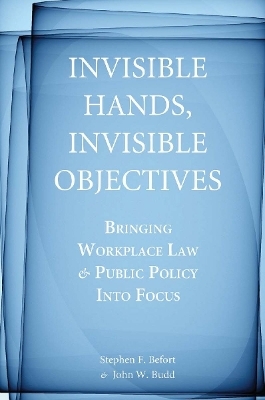
Invisible Hands, Invisible Objectives
Stanford University Press (Verlag)
978-0-8047-6154-3 (ISBN)
The global financial crisis and recession have placed great strains on the free market ideology that has emphasized economic objectives and unregulated markets. The balance of economic and noneconomic goals is under the microscope in every sector of the economy. It is time to re-think the objectives of the employment relationship and the underlying assumptions of how that relationship operates.
Invisible Hands, Invisible Objectives develops a fresh, holistic framework to fundamentally reexamine U.S. workplace regulation. A new scorecard for workplace law and public policy that embraces equity and voice for employees and economic efficiency will reveals significant deficiencies in our current practices. To create one, the authors—a legal scholar and an economics and industrial relations scholar—blend their expertise to propose a comprehensive set of reforms, tackling such issues as regulatory enforcement, portable employee benefits, training programs, living wages, workplace safety and health, work-family balance, security and social safety nets, nondiscrimination, good-cause dismissal, balanced income distributions, free speech protections for employees, individual and collective workplace decision-making, and labor unions.
Invisible Hands, Invisible Objectives is not just another book that sketches a reform agenda. The book provides the much-needed rubric for how we think about employment policy specifically, but also economic policy more generally. It is a must-read in these most critical times.
Stephen F. Befort is the Gray, Plant, Mooty, Mooty, and Bennett Professor of Law at the University of Minnesota Law School. He is the author of Employment Law and Practice, Second Edition (2003). John W. Budd is the Industrial Relations Land Grant Chair at the University of Minnesota's Carlson School of Management. He is the author of the award-winning Labor Relations: Striking a Balance (2006).
Table of Contents Preface Abbreviations Part I: Workplace Law and Public Policy XXX Chapter 1. The Goals and Assumptions of Workplace Law and Public Policy: The Need for Explicitness Explicit Objectives. Explicit Models. Explicit Reform. Workplace and Public Policy XXX. Chapter 2. The Evolution of U.S. Workplace Law and Public Policy: A Tapestry of Hidden Assumptions The Old Deal: Free Markets and Contracts Between Equals. The New Deal: Balancing Power Through Labor Unions and Fair Labor Standards. The Employment Law Era: Human Resource Management and Individual Rights. The Global Era: Free Trade and Personal Responsibility. Hidden Assumptions, Conflicting Assumptions Part II: An Explicit Scorecard for Workplace Law and Public Policy Chapter 3. Efficiency The Efficiency Scorecard. Globalization. Technology and Skills. Flexibility. Employee Benefits. Administrative Burdens of the Litigation Enforcement Model. Conclusion. Chapter 4. Equity Balancing Work and Non-Work Needs. A Living Wage. Balanced Income Distributions. Security and Social Safety Nets. Nondiscrimination and Fairness. Good Cause Dismissal. Nonstandard Work Arrangements. Conclusion. Chapter 5. Voice Employee Free Speech. Individual Self-Determination. Consultation, Codetermination, and Social Dialogue. Countervailing Collective Voice. Conclusion Part III: Creating Coherent Laws and Public Policies on Work Chapter 6. A Pluralist Manifesto for Workplace Law and Public Policy Analytical Insights, Normative Concerns. The Need for a Principled System of Workplace Law and Public Policy. A Pluralist Manifesto for Regulating the Employment Relationship. Chapter 7. Promoting Efficiency International Labor Standards. Training Programs. Flexibility. Weakening the Ties that Bind: Employee Benefits. A Coherent Body of Workplace Law. Promoting Efficiency. Chapter 8. Achieving Equity Balancing Work and Non-Work Needs. A Living Wage. Balanced Income Distributions. Security and Social Safety Nets. Nondiscrimination and Fairness. Good Cause Dismissal. Nonstandard Work Arrangements. Achieving Equity. Chapter 9. Facilitating Voice Employee Free Speech. Individual Self-Determination. Consultation, Codetermination, and Social Dialogue. Countervailing Collective Voice. Facilitating Voice. Chapter 10. Bringing Workplace Law and Public Policy Into Focus, and Balance000 The Difficulty of Legislative Reform. On What Level? Local, State, National, and International Reforms. Paying for (Im)Balance. Working Out a Balance. Notes000 Bibliography000 About the Authors000 Index000
| Erscheint lt. Verlag | 1.6.2009 |
|---|---|
| Zusatzinfo | 3 tables, 3 figures |
| Verlagsort | Palo Alto |
| Sprache | englisch |
| Maße | 152 x 229 mm |
| Gewicht | 431 g |
| Themenwelt | Recht / Steuern ► Arbeits- / Sozialrecht ► Arbeitsrecht |
| Recht / Steuern ► EU / Internationales Recht | |
| Wirtschaft ► Volkswirtschaftslehre | |
| ISBN-10 | 0-8047-6154-X / 080476154X |
| ISBN-13 | 978-0-8047-6154-3 / 9780804761543 |
| Zustand | Neuware |
| Haben Sie eine Frage zum Produkt? |
aus dem Bereich


